2021 MERCEDES-BENZ GLC warning
[x] Cancel search: warningPage 179 of 462
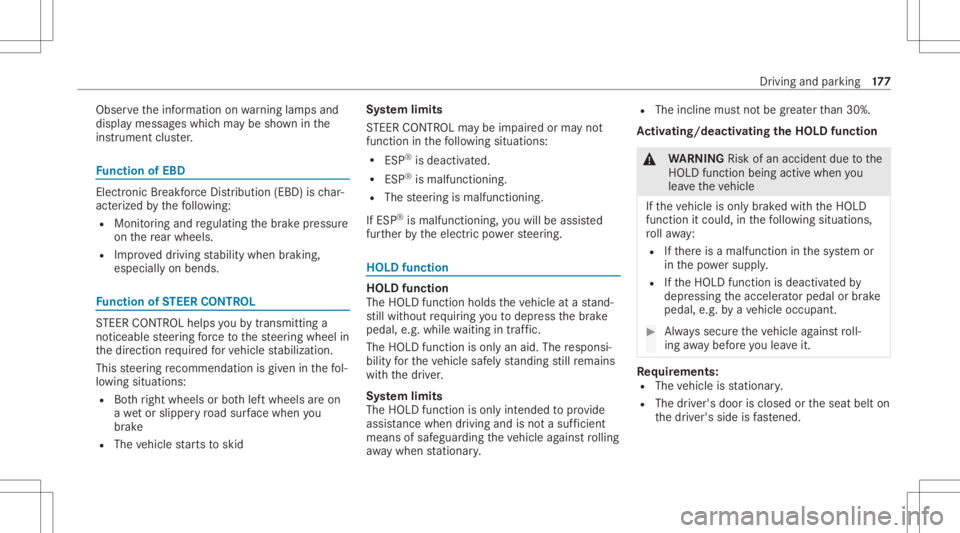
Obser
vetheinf ormation onwarning lam psand
displa ymess ages whic hma ybe sho wninthe
ins trumen tclus ter. Fu
nction ofEBD Elect
ronic Brea kfor ce Dis trib uti on (EBD) isch ar‐
act erize dby thefo llo wing:
R Mon itor ing and regulating thebr ak epr essur e
on there ar wheels .
R Improv ed driving stabilit ywhen brakin g,
espe ciallyon ben ds. Fu
nction ofSTEER CONT ROL ST
EER CONTR OLhelpsyo uby trans mitting a
no tice ablesteer ing forc eto thesteer ing wheel in
th edir ect ion requ ired forve hicle stabiliz ation.
This steer ing recomme ndation isgiv en inthefo l‐
lo wing situat ions:
R Both right wheels orboth leftwheels areon
a we tor slip pe ry road sur face whe nyo u
br ak e
R The vehicle star ts to skid Sy
stem limit s
ST EER CONTR OLmaybe impai redor ma yno t
func tion inthefo llo wing situat ions:
R ESP®
is deact ivat ed.
R ESP®
is malfun ctionin g.
R The steer ing ismalfunct ioning.
If ES P®
is malfunct ioning,youwill beassis ted
fur ther by theelectr icpo we rst eer ing. HOLD
function HOLD
function
The HOLD function holds theve hicle atast and‐
st ill wit hout requ iring youto depr essthebr ak e
pedal, e.g.while waitin gin traf fic.
The HOLD functionisonly anaid. The responsi‐
bility forth eve hicle safely standi ngstill remains
wit hth edr iver .
Sy stem limit s
The HOL Dfun ction isonl yint end edtoprov ide
assis tance when drivi ng and isno ta su fficien t
mean sof saf eguar dingtheve hicle agains tro lling
aw ay when statio nary. R
The incline mustno tbe great erthan 30%.
Ac tiv atin g/deac tivatin gthe HOL Dfun ction &
WARNIN GRisk ofan acci dent dueto the
HOLD functio nbei ng activ ewhe nyo u
lea vetheve hicle
If th eve hicle isonl ybr ak ed withth eHOLD
func tion itcould, inthefo llo wing situat ions,
ro llaw ay:
R Ifth er eis amalfunct ioninthesy stem or
in thepo we rsupp ly.
R Ifth eHOLD function isdeactiv ated by
depr essing theaccelera torpeda lor brak e
peda l,e.g. byave hicle occupant. #
Alw ayssecur eth eve hicle agains tro ll‐
ing away bef oreyo ulea veit. Re
quirement s:
R The vehicle isstatio nary.
R The driver's door isclosed ortheseat belton
th edr iver's side isfastened. Dr
iving andparking 17
7
Page 181 of 462
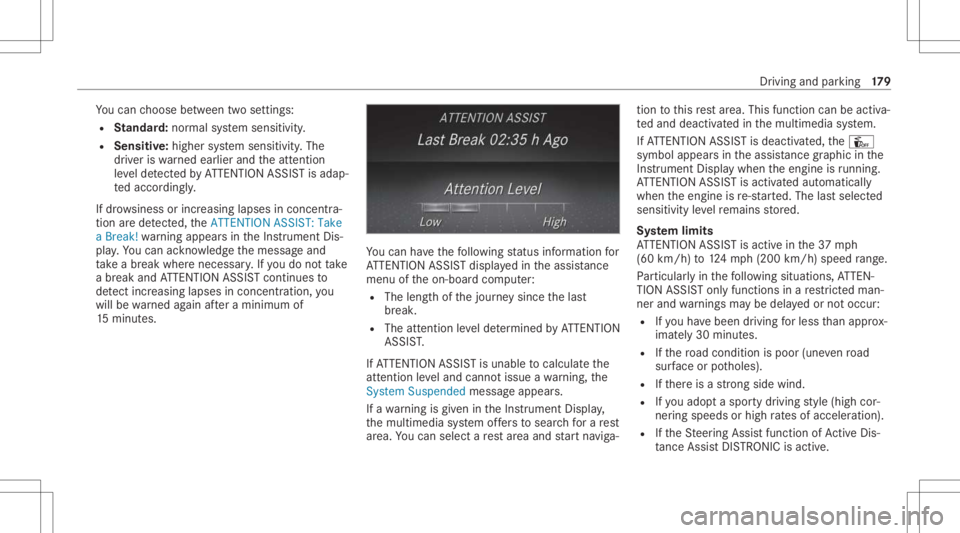
Yo
ucan choose between twose ttings:
R Standar d:nor mal system sensit ivity.
R Sensitiv e:higher system sensit ivity.The
dr iver iswa rned ear lier and theatt ent ion
le ve lde tected byATTENTION ASSISTis adap‐
te daccor dingly.
If dr ow siness orincr easing lapsesinconcen tra‐
tion arede tected, theATTE NTION ASSIS T:Take
a Break !wa rning appear sin theIns trument Dis‐
pla y.Yo ucan ackn ow ledg eth emessag eand
tak eabr eak wher eneces sary.Ifyo udo notta ke
a br eak and ATTENTION ASSISTcont inues to
de tect incr easing lapse sin concentr ation, you
will bewarned again afte ra minimu mof
15 minut es. Yo
ucan have thefo llo wing status informat ionfor
AT TENTION ASSISTdispla yedin theassis tance
menu oftheon- boar dcom puter:
R The lengt hof thejour neysince thelas t
br eak .
R The attent ion leve lde term ined byATTENTION
ASS IST.
If AT TENTION ASSISTis unable tocal cul ateth e
att ent ion leve land cannotissue awa rning, the
Sys tem Suspend edmes sage appear s.
If awa rning isgiv en intheIns trument Display,
th emultimedia system offers to sear chfora re st
ar ea. Youcan selectare st area and star tna vig a‐ tio
nto this rest area. This function can beact iva‐
te dand deactiv ated inthemultimedia system.
If AT TENTION ASSISTis deactiv ated, theÛ
symbol appearsin theassis tance grap hicin the
Ins trument Displaywhen theengine isrunning .
AT TENTION ASSISTis activ ated aut omaticall y
when theengine isre-sta rted. The lastselect ed
sensit ivityleve lre mains stor ed.
Sy stem limit s
AT TENTION ASSISTis activ ein the37 mph
(60 km/ h)to 124mp h(200 km/h) speedrang e.
Pa rticular lyin thefo llo wing situat ions,AT TEN‐
TION ASSISTonl yfunct ionsinare strict ed man‐
ner and warnings maybe dela yedor notocc ur:
R Ifyo uha ve been driving forless than appr ox‐
imat ely30 min utes.
R Ifth ero ad con dition ispoor (unevenro ad
sur face orpotholes).
R Ifth er eis ast ro ng side wind.
R Ifyo uadop ta spor tydrivin gst yle (high cor‐
ner ing speeds orhigh ratesof acceler ation).
R Ifth eSt eer ing Assis tfunc tion ofActiveDis ‐
ta nce AssistDIS TRONI Cis acti ve. Dr
iving and parking 17
9
Page 185 of 462
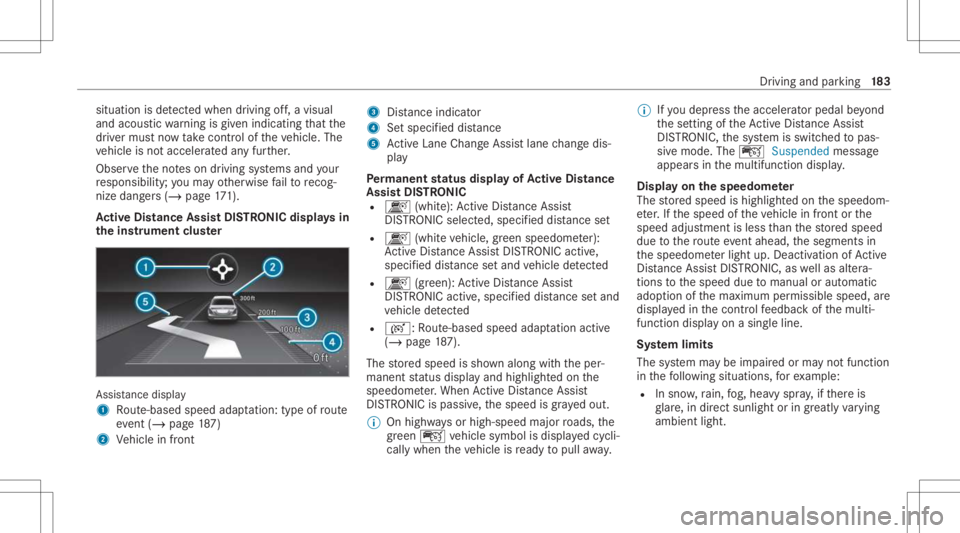
situation
isde tected whe ndr ivi ng off,avis ual
and acoustic warning isgiv en indic atingth at the
dr iver mus tno wtake contr olof theve hicle. The
ve hicle isno tacceler ated anyfur ther.
Obser vetheno teson driving systems andyour
re sponsibili ty;yo uma yot her wise failto recog‐
nize dangers(/ page 171).
Ac tiv eDi stance AssistDI ST RO NIC displa ysin
th eins trum ent clus ter Assi
stanc edispla y
1 Route-based speedadap tatio n:typ eof route
eve nt(/ page 187)
2 Vehicle infront 3
Distance indicator
4 Setspe cified dist anc e
5 ActiveLa ne Chang eAssi stlane chang edis‐
pla y
Pe rm anen tst atus displa yof Activ eDi stance
Ass istDI ST RO NIC
R k (white ):Ac tiveDis tance Assist
DIS TRONI Csel ect ed,sp eci fied distance set
R k (white vehicle, green speedome ter):
Ac tiveDis tance AssistDIS TRONI Cacti ve,
specif ieddistance setand vehicle detected
R k (green) :Ac tiveDis tance Assist
DIS TRONI Cacti ve,specif ieddistance setand
ve hicle detected
R r: Route-based speedadap tatio nacti ve
( / pag e18 7).
Th estor ed speed issho wnalong withth eper‐
manen tst atus displa yand highlight edon the
speedome ter.When ActiveDis tance Assist
DIS TRONI Cis pa ssi ve,th espeed isgray ed out.
% Onhighw aysor high-speed major roads, the
gr een ç vehicle symbol isdispla yedcy cli‐
cally when theve hicle isready topull away. %
Ifyo udepr esstheacceler ator pedal beyond
th ese tting oftheAc tiveDis tance Assist
DIS TRONI C,thesy stem isswitc hedtopas‐
siv emode. Theç Suspen dedmessag e
appear sin themultifunc tiondispla y.
Disp layon thespeed ometer
The stor ed speed ishighlight edon thespeedom‐
et er.If th espeed oftheve hicle infront orthe
speed adjustment isless than thestor ed speed
due tothero uteeve ntahead, thesegmen tsin
th espeedome terlig ht up. Deactiv ationofActive
Dis tance AssistDIS TRONI C,as wellas altera‐
tion sto thespeed duetomanua lor automatic
adop tionofthemaximum permissible speed,are
displa yedin thecon trol feedbac kof themulti‐
func tion displa yon asing leline.
Sy stem limit s
The system maybe impair edorma yno tfunc tion
in thefo llo wing situat ions,fo rex am ple:
R Insnow ,ra in, fog, hea vyspr ay,if th er eis
gl ar e, indir ect sunlight oringrea tly varying
ambien tlight . Dr
ivin gand parking18
3
Page 186 of 462

R
Ifth er eis swir ling dust,e.g. when driving off-
ro ad oron san dysur faces.
R The windsh ield inthear ea ofthecamer ais
dir ty,fo gg ed up, damag edorcovered.
R Ifth era dar sensor sar edir tyor covered.
R Inpar kingga rage sor on roads withsteep
uphill ordownhill gradients.
R Ifth er ear enar row vehicles infront, suchas
bicy cles ormo torcyc les.
In addition ,on slipper yro ads, brakin gor acc el‐
er atin gcan caus eon eor severalwheels tolose
tr act ion and theve hicle could then skid.
Do notuse ActiveDis tan ceAssi stDIS TRONI Cin
th ese situation s. &
WARNIN GRisk ofacci dent from acce ler‐
ati on orbraki ng byActiveDis tance
Assi stDIS TRONI C
Ac tiveDis tance AssistDIS TRONI Cma yacc el‐
er ateor brak ein thefo llo wing cases ,fo r
ex am ple:
R Ifth eve hicle pullsaway usin gAc tiveDis ‐
ta nce AssistDIS TRONI C.
R Ifth estor ed speed iscalled upand is
consider ablyfa ster or slo werth an the
cur rently driven spe ed.
R IfAc tiveDis tance AssistDIS TRONI Cno
lo ng er detects ave hicle infront ordoes
no tre act toreleva nt objects. #
Alw ayscar efully observethetraf fic con‐
di tions andbeready tobrak eat all
times. #
Take intoacc ount thetra ffic situat ion
bef orecallin gup thestor ed speed. &
WARNIN GRisk ofacci dent dueto insuf ‐
fi cie ntdece lera tio nby ActiveDis tance
Assi stDIS TRONI C
Ac tiveDis tance AssistDIS TRONI Cbrak es
yo ur vehicle withup to50% ofthepossible
deceler ation.Ifth is decele ratio nis no tsu ffi‐
cien t,Ac tiveDis tance AssistDIS TRONI C
al er ts youwit havis ual and acoustic warning. #
Adjus tyo ur spee dand main tain asuit a‐
ble distance from theve hicle infront. #
Brak eth eve hicle yourself and/or take
ev asiv eact ion. &
WARNIN GRisk ofacci dent ifde tection
functi onofActiveDis tance Assist
DIS TRONI Cis impai red
Ac tiveDis tance AssistDIS TRONI Cdo es not
re act orhas alimit edreact ion:
R when drivin gon adif fere nt lane orwh en
ch ang inglane s 18
4
Driving and parking
Page 192 of 462
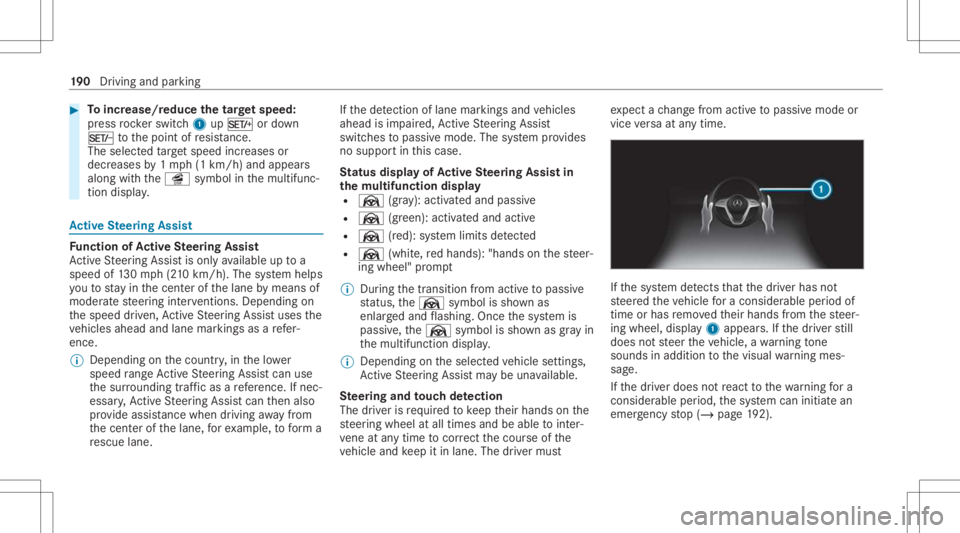
#
Toincr ease/r educethetar getspe ed:
pr ess rock er switc h1 upM ordown
N tothepoint ofresis tance.
The select edtarget speed increases or
decr eases by1mp h(1 km/h) andappea rs
alon gwit hth eî symbol inthemultifunc ‐
tion displa y. Ac
tiv eSte ering Assis t Fu
nction ofActiv eSte ering Assis t
Ac tiveSt eer ing Assis tis onl yav ailable uptoa
speed of130mp h(210 km/h) .The system helps
yo uto stay inthecent erofthelane bymeans of
moder atesteer ing interve ntio ns.Dep endingon
th espeed driven, ActiveSt eer ing Assis tuses the
ve hicles ahead andlane markings asare fer‐
ence.
% Dependi ngon thecount ry,in thelowe r
speed rang eAc tiveSt eer ing Assis tcan use
th esur round ingtraf fic as are fere nce. Ifnec‐
ess ary, Ac tiveSt eer ing Assis tcan then also
pr ov ide assis tance when drivi ng away from
th ecent erofthelane, forex am ple, toform a
re scue lane. If
th ede tection oflane mar kings andvehicles
ahead isim pair ed,ActiveSt eer ing Assis t
switc hestopassiv emode. Thesystem prov ides
no suppor tin this case.
St atus displa yof Activ eSte ering Assis tin
th emu ltifunct iondisp lay
R Ø (gra y): act ivat ed and pass ive
R Ø (gre en): activ ated and activ e
R Ø (red): system limits detected
R Ø (whit e,redhands): "handsonthesteer‐
ing wheel" prom pt
% During thetransition from activ eto passiv e
st atus ,th eØ symbol issho wnas
enlar gedand flashin g.On ce thesy stem is
passiv e,theØ symbol issho wnasgray in
th emultifunc tiondispla y.
% Dep endingontheselect edvehicle settin gs,
Ac tiveSt eer ing Assis tma ybe una vailable.
Ste ering and touc hde tection
The driver isrequ ired tokeep their hands onthe
st eer ing wheel atall times andbeable tointer‐
ve ne atanytime tocor rect thecour seofthe
ve hicle andkeep itin lane. Thedriver mus t ex
pect ach ang efrom active to passiv emode or
vice versaat anytim e. If
th esy stem detects that thedr iver has not
st eer edtheve hicle fora consider ableper iod of
time orhas remo vedth eir hands from thesteer‐
ing wheel, display1 appear s.Ifth edr iver still
does notst eer theve hicle, awa rning tone
sou nds inad ditio nto thevisual warning mes‐
sag e.
If th edr iver does notre act tothewa rning fora
consider ableper iod, thesy stem can initiat ean
emer gency stop (/ page19 2). 19
0
Driving and parking
Page 193 of 462

The
warning isno tissued orisstopped whenthe
dr iver giv es con firm atio nto thesy stem:
R The driver steer sth eve hicle.
R Depending onthecount ry:th edr iver
pr esses ast eer ing wheel buttonoroper ates
To uc hCon trol
If Ac tiveSt eer ing Assis tde tects that asy stem
limit hasbeen reac hed, avisual warning is
issued andawa rning tone sou nds.
Obs erve theno teson driving systems andyour
re sponsibili ty;yo uma yot her wise failto recog‐
nize dangers(/ page 171).
Sy stem limit s
Ac tiveSt eer ing Assis thas alimit edsteer ing tor‐
qu efo rlat eral gui dance. Insome cases, the
st eer ing interve ntio nis no tsu fficien tto keep the
ve hicle inthelane ortodrive th ro ugh exits.
The system maybe impair edorma yno tfunc tion
in thefo llo wing instances:
R The reispoor visibilit y,e.g. due tosno w,rain,
fo g, hea vyspr ay,gr ea tly varying ambien t
light orstro ng sha dows onthero ad. R
Ther eis glar e, e.g .fr om oncom ingtraf fic,
di re ct sunli ght orreflect ions.
R Insuf ficie ntroad illumin ation.
R The wind shieldisdir ty,fo gg ed up, damag ed
or coveredin thevicinit yof thecamer a,e.g.
by ast icke r.
R No,or several,unc lear lane markingsare
pr esen tfo rone lane, orthemar king sch ang e
qu ickl y, forex am ple, inacon stru ction area
or atintersecti ons.
R The lane mar kings arewo rnaw ay,dar kor
co veredup, e.g. bydirtor sno w.
R Ifth edis tance totheve hicle infront istoo
shor tand thus thelane marking scann otbe
de tected.
R The road isnar row and wind ing.
R Ther ear eobs tacle son thelane orprojec ting
out intoth elane, suchas objec tmar kers.
The system does notpr ov ide assis tance inthe
fo llo wing condition s:
R Ontigh tcur vesand when turning.
R When crossing intersections. R
Atround about sor tollplazas.
R When towing atrailer .
R When thetir epr essur eis toolow. &
WARNIN GRisk ofacci dent ifAc tive
St eer ing Assis tune xpect edlyst ops func‐
tionin g
If th esy stem limits ofActiveSt eer ing Assis t
ar ere ac hed ther eis no guar anteethat the
sy stem will remain activeor wil lke ep the
ve hicle inlane. #
Alw ayske ep your han dson thesteer ing
wheel andobser vethetra ffic car efull y. #
Alw aysst eer theve hicle paying atten‐
tion totraf fic condi tions. &
WARNIN GRisk ofacci dent ifAc tive
St eer ing Assis tune xpect edlyinterve nes
The detection oflane mar kings andobje cts
ma ymal functi onand causeune xpect ed
st eer ing interve ntio ns. #
Steer accor dingtotraf fic condi tions. Dr
iving and parking 19
1
Page 196 of 462
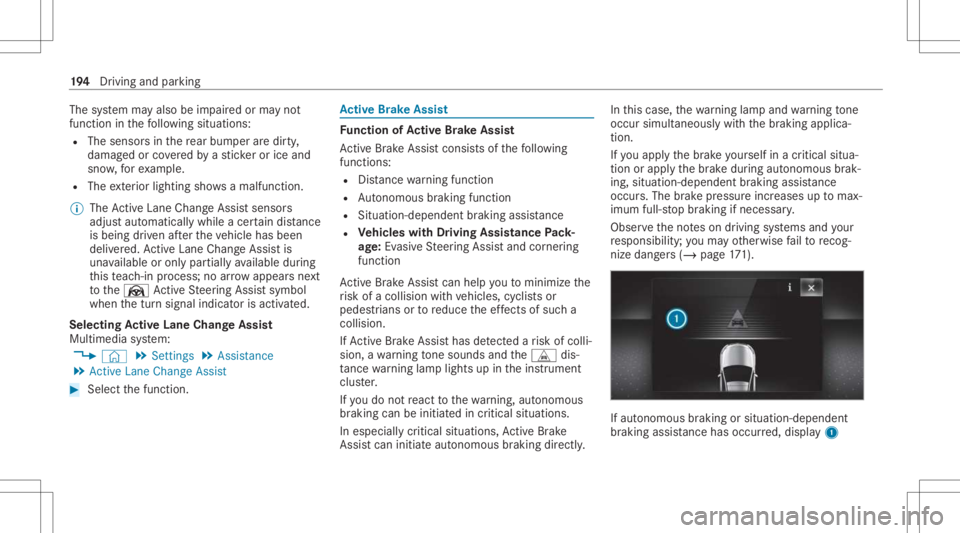
The
system mayalso beimpair edorma yno t
func tion inthefo llo wing situat ions:
R The sensorsin there ar bum peraredir ty,
damag edorcoveredby ast icke ror ice and
sno w,forex am ple.
R The exterior lighting showsamalf unction.
% The ActiveLa ne Chang eAssi stsensor s
adjus taut omaticall ywhile acer tain dis tance
is be ing driven afte rth eve hicle hasbeen
deliv ered. ActiveLa ne Chang eAssi stis
una vailable oronl ypar tiall yav ailable during
th is teac h-in proce ss;noarro w appear sne xt
to theØ ActiveSt eer ing Assis tsymbol
when thetur nsignal indicat orisactiv ated.
Selecting Activ eLan eCha ngeAs sist
Multimedia system:
4 © 5
Set ting s5
Assist ance
5 Act ive Lane Change Assist #
Select thefunc tion. Ac
tiv eBr ak eAs sist Fu
nction ofActiv eBr ak eAs sist
Ac tiveBr ak eAssi stconsi stsof thefo llo wing
func tions:
R Distance warning func tion
R Autonomo usbraki ng func tion
R Situ ation-d epend ent braki ng assist anc e
R Vehicl eswith Drivin gAss istanc ePa ck‐
ag e:Evasi ve Steer ing Assis tand corner ing
func tion
Ac tiveBr ak eAssi stcan helpyo uto minimize the
ri sk ofacollision withve hicles, cyclis tsor
pedes trians ortoreduce theef fects ofsuch a
coll ision.
If Ac tiveBr ak eAssi sthas detected arisk ofcolli‐
sion, awa rning tone sou nds and theL dis‐
ta nce warning lam plight sup intheins trument
clus ter.
If yo udo notre act tothewa rning, autono mous
br akin gcan beinit iated incritic alsituat ions.
In espec iallycritic alsituat ions,Ac tiveBr ak e
Assi stcan initia te aut onomo usbrakin gdir ect ly. In
this case, thewa rning lam pand warning tone
occu rsi mu ltane ously with thebr aking applica‐
tion .
If yo uappl yth ebr ak eyo urself inacr itical situa‐
tio nor appl yth ebr ak edur ing autonomous brak‐
ing, situation -dependen tbr aking assistance
occu rs.The brak epr ess ureincr eases uptomax‐
imum full-sto pbr aking ifnec essar y.
Obser vetheno teson driving systems andyour
re sponsibili ty;yo uma yot her wise failto recog‐
nize dangers(/ page 171). If
au tonomo usbraki ng orsitua tion-de pende nt
br aki ng assist anc ehas occurred, displa y1 19
4
Driving and parking
Page 197 of 462

appear
sin themultifunc tiondispla yand then
aut omaticall ygoes outafte ra shor ttime. &
WARNIN GRisk ofan acci dent caused by
limit eddetection perform anc eof Active
Br ak eAssi st
Ac tiveBr ak eAssi stcanno tal wa ys cle arly
ident ifyobje ctsand complextraf fic situ a‐
tions .
Ac tiveBr ak eAssi stisonl yan aid. Thedriver
is responsible formaint ainingasuf ficie ntly
saf edist anc eto theve hicle infront, vehicle
speed andforbr aking ingood time. #
Alw ayspa ycar eful attention tothetra f‐
fi c situ ation; donotre ly on ActiveBr ak e
Assi stalon e. #
Beprepar edtobrak eor sw erve ifnec ‐
essar y. Als
oob ser vethesy stem limits ofActiveBr ak e
Assi st. The
indiv idua lsub func tions areav ailab lein
va rious speed rang es:
The distance warning func tion canissue awa rn‐
ing inthefo llo wing situat ions:
R From appr oximat ely4 mp h(7 km/h), ifyo ur
ve hicle iscritically closetoave hicle, cyclis t
or pedes trian, youwill hear anintermit tent
wa rning tone and theL distance warning
lam plight sup intheins trument cluster.
Br ak eimme diat ely ortake evasiv eact ion,pr ov i‐
ded itis saf eto do soand thetra ffic situat ion
allo wsthis.
Dis tance warning funct ion(vehicles without
Dr iving Assistance Packag e)
The distance warning func tion canaidyouin the
fo llo wing situat ionswithan intermit tent wa rning
to ne and awa rning lam p:
R atspeeds uptoappr oximat ely15 5mp h
(250 km/h)when approaching vehicles
ahead
R atspeeds uptoappr oximat ely50 mph
(80 km/ h)when approaching statio naryve hi‐
cles, moving pedes trians andcyclis tsahead R
atspeeds uptoappr oximat ely37 mph
(60 km/ h)when approaching crossin g
cy clis ts
Dis tance warning funct ion(vehicles with
Dr iving Assistance Packag e)
The distance warning func tion canaidyouin the
fo llo wing situat ionswithan intermit tent wa rning
to ne and awa rning lam p:
R atspeeds uptoappr oximat ely15 5mp h
(250 km/h)when approaching vehicles
ahead
R atspeeds uptoappr oximat ely62 mph
(1 00 km/ h)when approaching statio nary
ve hicles
R atspeeds uptoappr oximat ely50 mph
(80 km/ h)when approaching moving pedes‐
tr ians andcyclis tsahead
R atspeeds uptoappr oximat ely43 mph
(70 km/ h)when approaching statio nary
pedes trians ,cr oss ing vehicles andstatio nary
and cross ing cyclis ts Dr
ivin gand parking19
5